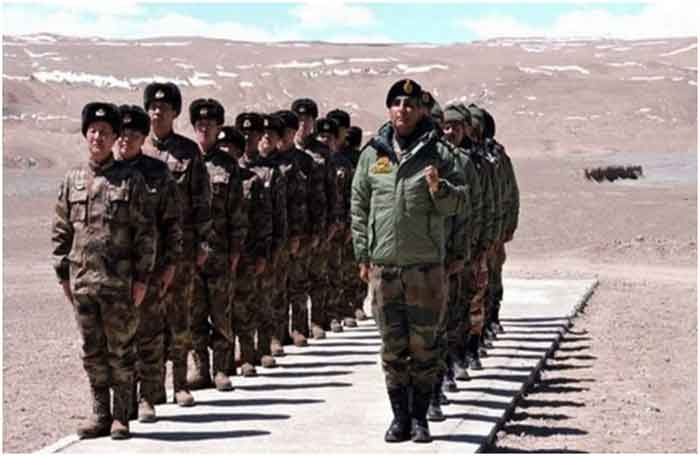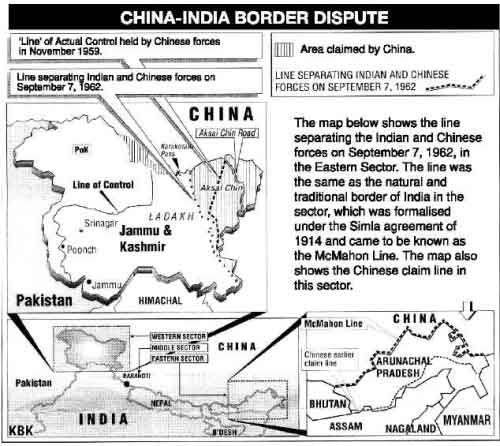
India was constructing some activities along its side of line of actual control in the Galvan valley and this Galvan Valley there was no real dispute on this. It was for long considered to be part of Indian territory. There was no such real dispute on the Galvan valley. But for the first time in more than four and half decades, China is claiming Galvan valley as its territory. In fact, Global Times which is highly respected and very influential newspaper in China, sometimes referred to as the mouthpiece of the Chinese government; it has claimed in one of it’s articles that Galvan valley was always a part of China. So when Indian side was constructing roads, some activities on the Galvan valley along its side of line of actual control, the Chinese army interfered and infiltrated into this line of actual control and entered the Galvan valley. There was a standoff between India and China on hot springs as well and at the same time on four to eight fingers China has already constructed a metallic road and in fact if the newspaper reports are to be believed, China is also patrolling finger four as well which was still recently patrolled by the Indian army.
But particularly interesting is the Galvan valley. What happened on the Indian side of line of actual control which is Galvan valley as well and which is part of India’s territory; India was constructing some roads, installations on its side of line of actual control. This infuriated the China and Chinese army crossed the line of actual control and entered the Galvan valley. This is where they pitched their tents as well and this what led to the confrontation between the Indian and the Chinese army. There were fistfights luckily no bullets were fired, although there are some reports which say that bullets were indeed fired and if those reports are true then for the first time since 1975 bullets have been fired between India and China along the line of actual control. Be that as it may, this is where both sides then decides to de-escalate.
De-escalation would be that China would withdraw from the Galvan valley. India would also withdraw from the Galvan valley that is what we call de-escalation but China withdrawing from the Galvan valley is understood because it is not their territory but why would India withdraw from Galvan valley. This is where there is an ambiguity, we don’t have a clarity whether India did withdraw from Galvan valley or China also withdrew from Galvan valley but what exactly happened on that standoff night, it is argued that these tents which were pitched by the Chinese army and when they were withdrawing which means when de-escalation was going on, the Indian army attacked these tents, burnt them, destroyed them which also infuriated Chinese and this resulted in the fist fight and unfortunately 20 Indian army personnel were killed. There are reports of casualties on the Chinese side as well. According to ANI which is Indian News Agency 43 Chinese soldiers have also lost their lives. But if we look at unofficial reports, it is argued that the number of casualties may rise because in this fist fight some of the army men both from India and China have fallen into the icy water of Galvan river. So, the number of casualties may rise and since the number of casualties have been rising that’s what makes this current escalation as one of the deadliest ones, which requires urgent de-escalation as well as resolution.
There is mistrust between the two countries. China is expanding not only its territorial claims but also its influence both militarily as well as economically. So, the aggressive position of China on the South China Sea, the dispute with Japan, the rising tensions between China and United states and the India coming closer to the United States and the events like Howdy Modi and Namaste Trump generated a lot of mistrust amongst the Chinese authorities and they viewed India as a proxy of US in the neighbourhood and the situation is further complicated by what is happening in our neighbourhood. If we look at Line of control, it is hot by repeated ceasefire violations from both sides; there is actual activity going on along the LAC between India and China. On Afghanistan also if we look at Afghanistan in our neighbourhood there are peace talks between United States and other world powers and in all likelihood Taliban will be given Afghanistan on its platter and Taliban will rule Afghanistan and biggest victory would be that of Pakistan because ìt is Pakistan which has brought Taliban on the negotiating table and what is happening in Afghanistan, the talks between Taliban and other world powers, India is completely missing. If we look at Nepal, there is a real clash for the first time between India and Nepal. Some of territories which India consider as its territory; have been included in Nepal’s territories. The map of Nepal was amended recently by the Chinese parliament and some of the Indian territories such as Kala Pani were included in the Nepal territories. On top of that Bangladesh which was once considered to be the shining example of India’s diplomacy; is also upset with India because of CAA. So, Bangladesh, Nepal, China, Pakistan and Afghanistan rose the serious diplomatic crises that the current government is facing and that is what complicates the existing standoff between India and China.
The Foreign Policy Magazine has said that government of India’s actions on Jammu and Kashmir by diluting Article 370, by reorganizing the state of Jammu and Kashmir into two Union territories. These actions have given an opening to China, so that China can interfere in Jammu and Kashmir, why? this is where it becomes more interesting. If we look at Article 1 of the constitution of India, it talks about the territory of India. It says the territory of India shall consist of states and or union territories and or acquired territories. This is where it becomes even more interesting. When we look at states for the first time and the only time we have used a prefix called Indian state of Jammu and Kashmir. This prefix we have not used for any other state. And what is this Indian state of Jammu and Kashmir which came into existence immediately prior to the commencement of the constitution. When did the Indian constitution commence for that we may have two dates: 26th November 1949 or 26th January 1950. So, when constitution of India under article 1 talks about the Indian state of Jammu and Kashmir and what is this Indian state of Jammu and Kashmir, which was present at the time of the commencement of the constitution, which can be either of these two dates but at this time one part of Jammu and Kashmir was already occupied by Pakistan called Pakistan Administered Kashmir. So, does that mean that under article 1 of the constitution, India has given up it’s claim on Pakistan occupied Kashmir, no why, constitutional experts say this definition was deliberate, why, because at this point in time we were waiting for constitution of Jammu and Kashmir, because constituent Assembly of Jammu and Kashmir would have to draft the constitution of Jammu and Kashmir. So, let’s wait and watch what constituent assembly of Jammu and Kashmir talks about the territory of Jammu and Kashmir. The constituent Assembly of Jammu and Kashmir in the year 1956-57 gave its own constitution and it unambiguously states Jammu and Kashmir is an integral part of India and what is this Indian state of Jammu and Kashmir; the state which existed on August 15th 1947. That means the definition of state of Jammu and Kashmir is the state which existed on August 15th 1947. But look at this it becomes even more interesting here, on August 5th & 6th 2019 what government of India did? The government of India discarded the constitution of Jammu and Kashmir. It was this constitution of Jammu and Kashmir which made the entire territory of Jammu and Kashmir as an integral part of India, otherwise the constitution of India under Article 1 would only say the state of Jammu and Kashmir which existed at the time of commencement of the constitution and that is why some people say because constitution of Jammu and Kashmir has been rendered ineffective has been discarded which means there no definition of territory of Jammu and Kashmir which basically have given China an open hand to interfere in this Jammu and Kashmir question because there are some experts that if tomorrow China come on the negotiating table India would claim the entire state of Jammu and Kashmir as its own, China would ask for proof and China would say that the Constitution of Jammu and Kashmir has been thrown into the dustbins of the history so, there is no territorial definition of the state of Jammu and Kashmir which you can claim. Some people also say Home Minister Amit Shah’s statement in the parliament when the government moved resolutions on Article 370 wherein the Home Minister said that the entire region of Aksai Chin (Aksai Chin is considered as part of Ladakh by India but China considers it as part of their autonomous region called Zing Zang province) is also an Indian territory and we will give our blood to bring it back that is also what infuriated the Chinese authorities.
But now, what is the way forward. The situation is quit serious, hand to hand combat has taken place. There is a solace that no bullets were fired otherwise, it would have been very difficult to de-escalate the tensions between two countries. There is a hope that diplomacy triumphs and there is a solution to the present crises only through talks and there is no need to go to a war because that is going to be disastrous for the both the countries. The way forward would be that instead of military of the two countries talking to each other, instead of the lieutenant general’s talking to each other ; let there be a Foreign Minister level conversation between India and Chinese side, that will go a long way in de-escalating these tensions.
Shabir Ahmad is a Freelance Writer from Raiyar Doodhpathri and writes regularly on current affairs. He can be reached at [email protected].
SIGN UP FOR COUNTERCURRENTS DAILY NEWSLETTER












































